The Effect of Polymer Blends on the In Vitro Release/Degradation and Pharmacokinetics of Moxidectin-Loaded PLGA Microspheres
Abstract
:1. Introduction
2. Results and Discussion
2.1. Physicochemical Properties of MOX-MS
2.2. In Vitro Release of MOX-MS
2.2.1. In Vitro Release of MOX-MS at 37 °C
2.2.2. In Vitro Release of MOX-MS at 50 °C/60 °C
2.3. In Vitro Degradation Mechanism of MOX-MS
2.3.1. Mass Changes of MOX-MS
2.3.2. Polymer Mw of MOX-MS
2.3.3. pH Changes of Release Medium
2.3.4. MOX-MS Morphological Changes
2.4. Pharmacokinetic Evaluation
3. Materials and Methods
3.1. Materials
3.2. Preparation of Microspheres
3.3. Characterization of MOX-MS
3.3.1. Particle Size and Size Distribution
3.3.2. Morphology
3.3.3. Drug Loading and Encapsulation Efficiency
3.3.4. Powder X-ray Diffraction Analysis
3.3.5. Surface Contact Angle
3.4. In Vitro Release
3.5. In Vitro Degradation Mechanism Studies
3.5.1. Mass Changes of Microspheres
3.5.2. Morphological Characterization of Microspheres
3.5.3. Molecular Weight Analysis
3.5.4. pH of Release Medium at Different Release Stages
3.6. Pharmacokinetics Study
3.7. Statistical Analysis
4. Conclusions
Supplementary Materials
Author Contributions
Funding
Institutional Review Board Statement
Informed Consent Statement
Data Availability Statement
Acknowledgments
Conflicts of Interest
References
- Su, Y.; Zhang, B.; Sun, R.; Liu, W.; Zhu, Q.; Zhang, X.; Wang, R.; Chen, C. PLGA-based biodegradable microspheres in drug delivery: Recent advances in research and application. Drug Deliv. 2021, 28, 1397–1418. [Google Scholar] [CrossRef] [PubMed]
- Hua, Y.; Su, Y.; Zhang, H.; Liu, N.; Wang, Z.; Gao, X.; Gao, J.; Zheng, A. Poly(lactic-co-glycolic acid) microsphere production based on quality by design: A review. Drug Deliv. 2021, 28, 1342–1355. [Google Scholar] [CrossRef] [PubMed]
- Anderson, J.M.; Shive, M.S. Biodegradation and biocompatibility of PLA and PLGA microspheres. Adv. Drug Deliv. Rev. 2012, 64, 72–82. [Google Scholar] [CrossRef]
- Butreddy, A.; Gaddam, R.P.; Kommineni, N.; Dudhipala, N.; Voshavar, C. PLGA/PLA-Based Long-Acting Injectable Depot Microspheres in Clinical Use: Production and Characterization Overview for Protein/Peptide Delivery. Int. J. Mol. Sci. 2021, 22, 8884. [Google Scholar] [CrossRef]
- Freiberg, S.; Zhu, X. Polymer microspheres for controlled drug release. Int. J. Pharm. 2004, 282, 1–18. [Google Scholar] [CrossRef]
- Ravivarapu, H.B.; Burton, K.; DeLuca, P.P. Polymer and microsphere blending to alter the release of a peptide from PLGA microspheres. Eur. J. Pharm. Biopharm. 2000, 50, 263–270. [Google Scholar] [CrossRef]
- Park, K.; Otte, A.; Sharifi, F.; Garner, J.; Skidmore, S.; Park, H.; Jhon, Y.K.; Qin, B.; Wang, Y. Formulation composition, manufacturing process, and characterization of poly(lactide-co-glycolide) microparticles. J. Control. Release 2021, 329, 1150–1161. [Google Scholar] [CrossRef]
- Zhang, H.; Pu, C.; Wang, Q.; Tan, X.; Gou, J.; He, H.; Zhang, Y.; Yin, T.; Wang, Y.; Tang, X. Physicochemical Characterization and Pharmacokinetics of Agomelatine-Loaded PLGA Microspheres for Intramuscular Injection. Pharm. Res. 2019, 36, 9. [Google Scholar] [CrossRef]
- da Silva, R.Y.P.; de Menezes, D.L.B.; Oliveira, V.D.; Converti, A.; de Lima, A.A.N. Microparticles in the Development and Improvement of Pharmaceutical Formulations: An Analysis of In Vitro and In Vivo Studies. Int. J. Mol. Sci. 2023, 24, 5441. [Google Scholar] [CrossRef]
- Ochi, M.; Wan, B.; Bao, Q.; Burgess, D.J. Influence of PLGA molecular weight distribution on leuprolide release from microspheres. Int. J. Pharm. 2021, 599, 120450. [Google Scholar] [CrossRef]
- Lim, Y.W.; Tan, W.S.; Ho, K.L.; Mariatulqabtiah, A.R.; Abu Kasim, N.H.; Abd Rahman, N.; Wong, T.W.; Chee, C.F. Challenges and Complications of Poly(lactic-co-glycolic acid)-Based Long-Acting Drug Product Development. Pharmaceutics 2022, 14, 614. [Google Scholar] [CrossRef] [PubMed]
- Zhu, C.; Peng, T.; Huang, D.; Feng, D.; Wang, X.; Pan, X.; Tan, W.; Wu, C. Formation Mechanism, In vitro and In vivo Evaluation of Dimpled Exenatide Loaded PLGA Microparticles Prepared by Ultra-Fine Particle Processing System. AAPS PharmSciTech 2019, 20, 64. [Google Scholar] [CrossRef] [PubMed]
- Nkanga, C.I.; Fisch, A.; Rad-Malekshahi, M.; Romic, M.D.; Kittel, B.; Ullrich, T.; Wang, J.; Krause, R.W.M.; Adler, S.; Lammers, T.; et al. Clinically established biodegradable long acting injectables: An industry perspective. Adv. Drug Deliv. Rev. 2020, 167, 19–46. [Google Scholar] [CrossRef]
- Zolnik, B.S.; Leary, P.E.; Burgess, D.J. Elevated temperature accelerated release testing of PLGA microspheres. J. Control. Release 2006, 112, 293–300. [Google Scholar] [CrossRef] [PubMed]
- Tamani, F.; Bassand, C.; Hamoudi, M.C.; Siepmann, F.; Siepmann, J. Mechanistic explanation of the (up to) 3 release phases of PLGA microparticles: Monolithic dispersions studied at lower temperatures. Int. J. Pharm. 2021, 596, 120220. [Google Scholar] [CrossRef] [PubMed]
- Zhai, J.; Ou, Z.; Zhong, L.; Wang, Y.-E.; Cao, L.-P.; Guan, S. Exenatide-loaded inside-porous poly(lactic-co-glycolic acid) microspheres as a long-acting drug delivery system with improved release characteristics. Drug Deliv. 2020, 27, 1667–1675. [Google Scholar] [CrossRef]
- Duvvuri, S.; Janoria, K.G.; Mitra, A.K. Effect of polymer blending on the release of ganciclovir from PLGA microspheres. Pharm. Res. 2006, 23, 215–223. [Google Scholar] [CrossRef]
- Xiao, P.; Qi, P.; Chen, J.; Song, Z.; Wang, Y.; He, H.; Tang, X.; Wang, P. The effect of polymer blends on initial release regulation and in vitro-in vivo relationship of peptides loaded PLGA-Hydrogel Microspheres. Int. J. Pharm. 2020, 591, 119964. [Google Scholar] [CrossRef]
- Wang, T.; Xue, P.; Wang, A.; Yin, M.; Han, J.; Tang, S.; Liang, R. Pore change during degradation of octreotide acetate-loaded PLGA microspheres: The effect of polymer blends. Eur. J. Pharm. Sci. 2019, 138, 104990. [Google Scholar] [CrossRef]
- Wang, L.; Chaw, C.S.; Yang, Y.Y.; Moochhala, S.M.; Zhao, B.; Ng, S.; Heller, J. Preparation, characterization, and in vitro evaluation of physostigmine-loaded poly(ortho ester) and poly(ortho ester)/poly(D,L-lactide-co-glycolide) blend microspheres fabricated by spray drying. Biomaterials 2004, 25, 3275–3282. [Google Scholar] [CrossRef]
- Fang, Y.; Zhang, N.; Li, Q.; Chen, J.; Xiong, S.; Pan, W. Characterizing the release mechanism of donepezil-loaded PLGA microspheres in vitro and in vivo. J. Drug Deliv. Sci. Technol. 2019, 51, 430–437. [Google Scholar] [CrossRef]
- Yoo, J.; Won, Y.Y. Phenomenology of the Initial Burst Release of Drugs from PLGA Microparticles. ACS Biomater. Sci. Eng. 2020, 6, 6053–6062. [Google Scholar] [CrossRef] [PubMed]
- Awasthi, A.; Razzak, M.; Al-Kassas, R.; Harvey, J.; Garg, S. Analytical Profile of Moxidectin. In Profiles of Drug Substances, Excipients, and Related Methodology; Brittain, H.G., Ed.; Elsevier: Amsterdam, The Netherlands, 2013; Volume 38, pp. 315–366. [Google Scholar]
- Savadelis, M.D.; McTier, T.L.; Kryda, K.; Maeder, S.J.; Woods, D.J. Moxidectin: Heartworm disease prevention in dogs in the face of emerging macrocyclic lactone resistance. Parasites Vectors 2022, 15, 1–11. [Google Scholar] [CrossRef]
- Han, F.Y.; Thurecht, K.J.; Whittaker, A.K.; Smith, M.T. Bioerodable PLGA-Based Microparticles for Producing Sustained-Release Drug Formulations and Strategies for Improving Drug Loading. Front. Pharmacol. 2016, 7, 185. [Google Scholar] [CrossRef]
- Gu, B.; Wang, Y.; Burgess, D.J. In vitro and in vivo performance of dexamethasone loaded PLGA microspheres prepared using polymer blends. Int. J. Pharm. 2015, 496, 534–540. [Google Scholar] [CrossRef] [PubMed]
- Rumondor, A.C.; Wikström, H.; Van Eerdenbrugh, B.; Taylor, L.S. Understanding the tendency of amorphous solid dispersions to undergo amorphous-amorphous phase separation in the presence of absorbed moisture. AAPS PharmSciTech 2011, 12, 1209–1219. [Google Scholar] [CrossRef] [PubMed]
- Awasthi, A.; Razzak, M.; Al-Kassas, R.; Greenwood, D.R.; Harvey, J.; Garg, S. Isolation and characterization of degradation products of moxidectin using LC, LTQ FT-MS, H/D exchange and NMR. Anal. Bioanal. Chem. 2012, 404, 2203–2222. [Google Scholar] [CrossRef]
- Shen, J.; Burgess, D.J. Accelerated in-vitro release testing methods for extended-release parenteral dosage forms. J. Pharm. Pharmacol. 2012, 64, 986–996. [Google Scholar] [CrossRef]
- Karavelidis, V.; Giliopoulos, D.; Karavas, E.; Bikiaris, D. Nanoencapsulation of a water soluble drug in biocompatible polyesters. Effect of polyesters melting point and glass transition temperature on drug release behavior. Eur. J. Pharm. Sci. 2010, 41, 636–643. [Google Scholar] [CrossRef]
- Kohno, M.; Andhariya, J.V.; Wan, B.; Bao, Q.; Rothstein, S.; Hezel, M.; Wang, Y.; Burgess, D.J. The effect of PLGA molecular weight differences on risperidone release from microspheres. Int. J. Pharm. 2020, 582, 119339. [Google Scholar] [CrossRef]
- Ford Versypt, A.N.; Arendt, P.D.; Pack, D.W.; Braatz, R.D. Derivation of an Analytical Solution to a Reaction-Diffusion Model for Autocatalytic Degradation and Erosion in Polymer Microspheres. PLoS ONE 2015, 10, e0135506. [Google Scholar] [CrossRef] [PubMed]
- Gaignaux, A.; Réeff, J.; De Vriese, C.; Goole, J.; Amighi, K. Evaluation of the degradation of clonidine-loaded PLGA microspheres. J. Microencapsul. 2013, 30, 681–691. [Google Scholar] [CrossRef] [PubMed]
- Desai, K.G.; Olsen, K.F.; Mallery, S.R.; Stoner, G.D.; Schwendeman, S.P. Formulation and in vitro-in vivo evaluation of black raspberry extract-loaded PLGA/PLA injectable millicylindrical implants for sustained delivery of chemopreventive anthocyanins. Pharm. Res. 2010, 27, 628–643. [Google Scholar] [CrossRef]
- Vert, M.; Mauduit, J.; Li, S. Biodegradation of PLA/GA polymers: Increasing complexity. Biomaterials 1994, 15, 1209–1213. [Google Scholar] [CrossRef] [PubMed]
- Jonnalagadda, S.; Robinson, D.H. A bioresorbable, polylactide reservoir for diffusional and osmotically controlled drug delivery. AAPS PharmSciTech 2000, 1, E29. [Google Scholar] [CrossRef] [PubMed]
- Makadia, H.K.; Siegel, S.J. Poly Lactic-co-Glycolic Acid (PLGA) as Biodegradable Controlled Drug Delivery Carrier. Polymers 2011, 3, 1377–1397. [Google Scholar] [CrossRef]
- Fu, K.; Pack, D.W.; Klibanov, A.M.; Langer, R. Visual evidence of acidic environment within degrading poly(lactic-co-glycolic acid) (PLGA) microspheres. Pharm. Res. 2000, 17, 100–106. [Google Scholar] [CrossRef]
- Brunner, A.; Mäder, K.; Göpferich, A. pH and osmotic pressure inside biodegradable microspheres during erosion. Pharm. Res. 1999, 16, 847–853. [Google Scholar] [CrossRef]
- Hofmann, D.; Sayasone, S.; Keiser, J. Development and validation of an LC-MS/MS method for the quantification of the anthelmintic drug moxidectin in a volumetric absorptive microsample, blood, and plasma: Application to a pharmacokinetic study of adults infected with Strongyloides stercoralis in Laos. J. Chromatogr. B Anal. Technol. Biomed. Life Sci. 2021, 1166, 122556. [Google Scholar]
- Odonnell, P.B.; McGinity, J.W. Preparation of microspheres by the solvent evaporation technique. Adv. Drug Deliv. Rev. 1997, 28, 25–42. [Google Scholar] [CrossRef]
- Andhariya, J.V.; Burgess, D.J. Recent advances in testing of microsphere drug delivery systems. Expert Opin. Drug Deliv. 2016, 13, 593–608. [Google Scholar] [CrossRef]
- D’Souza, S.; Faraj, J.A.; Dorati, R.; DeLuca, P.P. A Short Term Quality Control Tool for Biodegradable Microspheres. AAPS PharmSciTech 2014, 15, 530–541. [Google Scholar] [CrossRef] [PubMed]
- Hazra, M.; Mandal, D.D.; Mandal, T.; Rao, B.P.; Samaddar, S. Optimization and characterization of hepatoprotective andrographolide microspheres in the necrotic rat model. J. Drug Deliv. Sci. Technol. 2021, 65, 102679. [Google Scholar] [CrossRef]
- Corrigan, O.I.; Heelan, B.A. Characterization of drug release from diltiazem-loaded polylactide microspheres prepared using sodium caseinate and whey protein as emulsifying agents. J. Microencapsul. 2001, 18, 335–345. [Google Scholar] [PubMed]
- Magri, G.; Selmin, F.; Cilurzo, F.; Fotaki, N. Biorelevant release testing of biodegradable microspheres intended for intra-articular administration. Eur. J. Pharm. Biopharm. 2019, 139, 115–122. [Google Scholar] [CrossRef] [PubMed]
- Andhariya, J.V.; Jog, R.; Shen, J.; Choi, S.; Wang, Y.; Zou, Y.; Burgess, D.J. In vitro-in vivo correlation of parenteral PLGA microspheres: Effect of variable burst release. J. Control. Release 2019, 314, 25–37. [Google Scholar] [CrossRef]
- Fazzio, L.; Moreno, L.; Galvan, W.; Canton, C.; Alvarez, L.; Streitenberger, N.; Sanchez, R.; Lanusse, C.; Sanabria, R. Pharmacokinetic profile and anthelmintic efficacy of moxidectin administered by different doses and routes to feedlot calves. Vet. Parasitol. 2019, 266, 73–79. [Google Scholar] [CrossRef]
- Buchter, V.; Hofmann, D.; Haeberli, C.; Keiser, J. Characterization of Moxidectin against Strongyloides ratti: In Vitro and In Vivo Activity and Pharmacokinetics in the Rat Model. ACS Infect. Dis. 2021, 7, 1069–1076. [Google Scholar] [CrossRef]
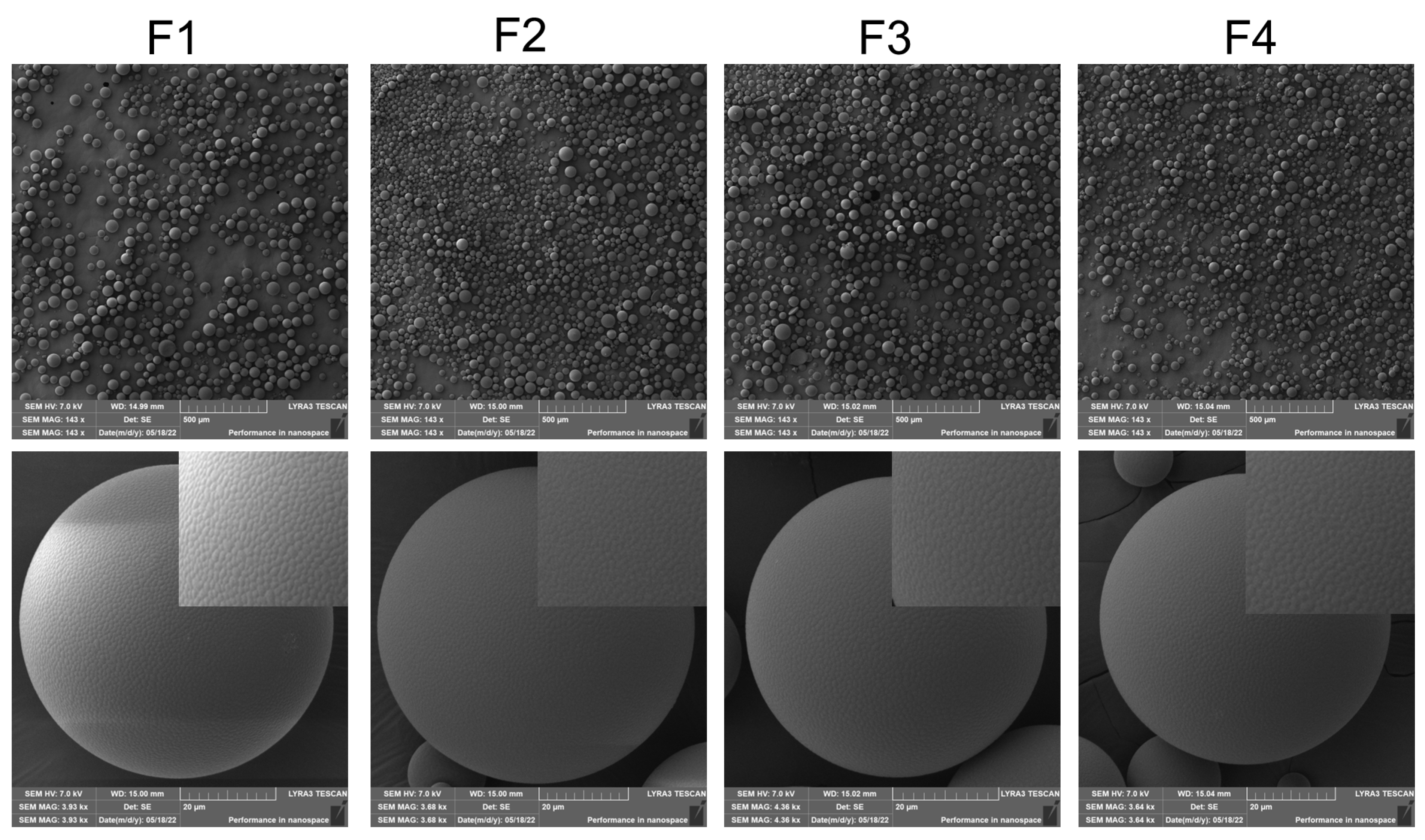
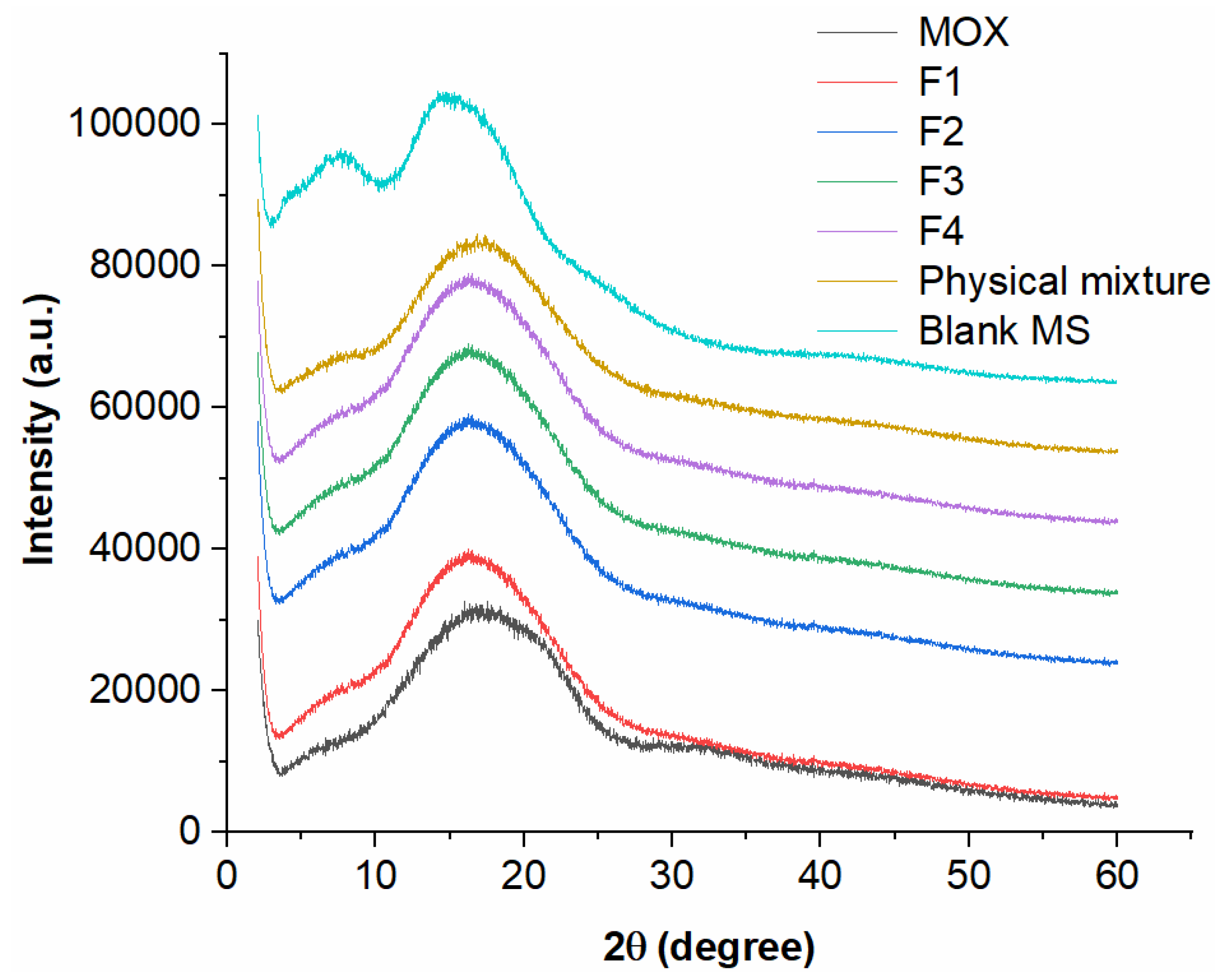
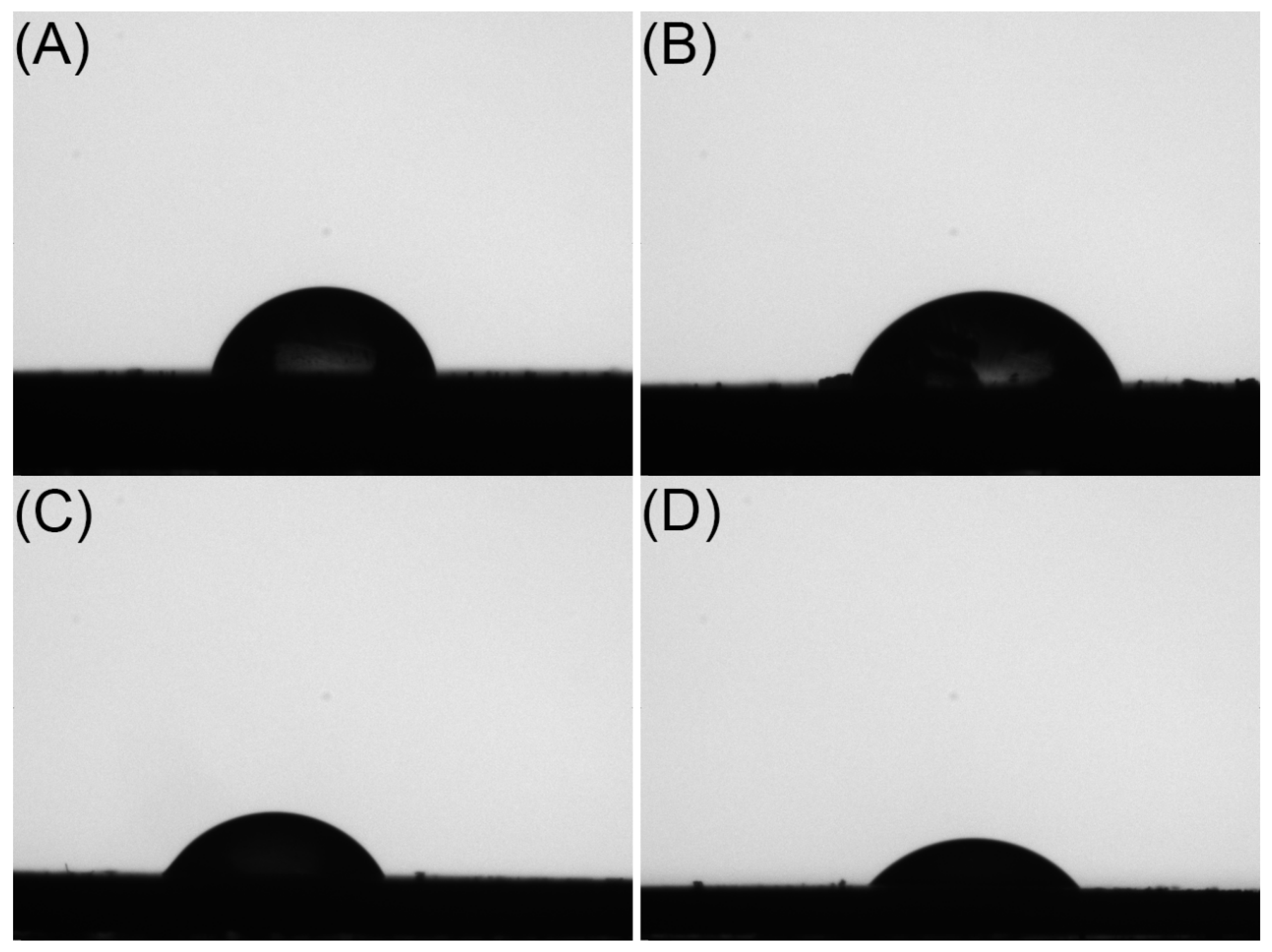


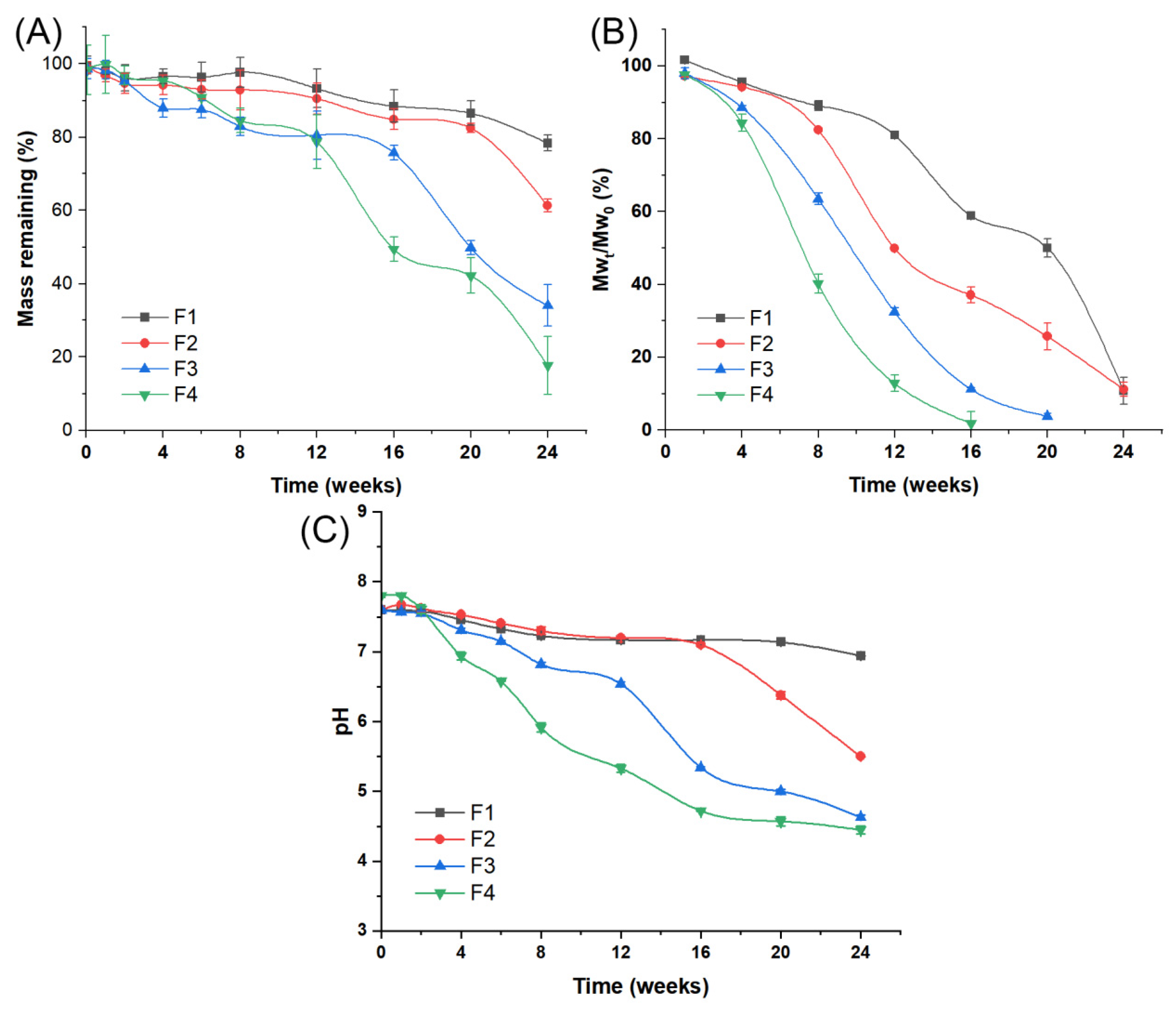


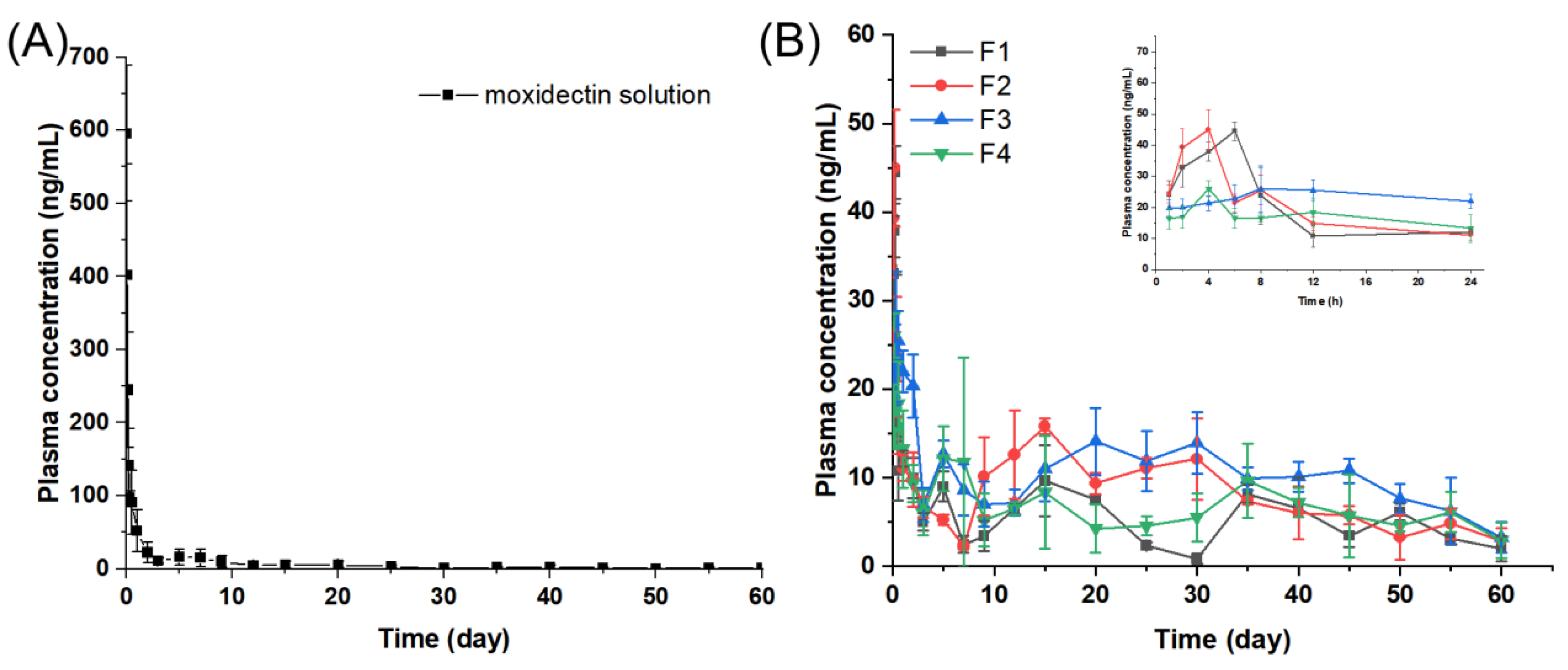
| Formulation | The Proportion of PLGA (75 kDa) to PLGA (23 kDa) | Drug Loading (%) | Encapsulation Efficiency (%) | Mean Particle Size (μm) | Span Value |
|---|---|---|---|---|---|
| F1 | 1:0 | 35.41 ± 0.26 | 88.3 ± 0.69 | 47.723 ± 1.911 | 1.305 ± 0.097 |
| F2 | 9:1 | 36.22 ± 0.14 | 91.0 ± 0.12 | 46.899 ± 1.665 | 1.297 ± 0.071 |
| F3 | 2:1 | 36.51 ± 0.21 | 91.7 ± 0.14 | 43.371 ± 1.836 | 1.325 ± 0.077 |
| F4 | 1:1 | 36.49 ± 0.21 | 91.8 ± 0.16 | 40.784 ± 2.101 | 1.276 ± 0.081 |
| Formulation | 37 °C | 50 °C | 60 °C |
|---|---|---|---|
| Sigmoidal Equation | Sigmoidal Equation | Zero-Order Equation | |
| F1 | Q = 100.04 – 94.56/(1 + e((t−182.17)/11.64)) R2 = 0.984 | Q = 123.64 – 118.63/(1 + e((t−23.24)/5.00)) R2 = 0.914 | Q = 5.52t + 5.97 R2 = 0.978 |
| F2 | Q = 90.91 – 85.65/(1 + e((t−131.90)/11.75)) R2 = 0.996 | Q = 101.23 – 96.34/(1 + e((t−17.22)/3.47)) R2 = 0.989 | Q = 5.37t + 6.11 R2 = 0.977 |
| F3 | Q = 89.51 – 84.45/(1 + e((t−104.99)/8.17)) R2 = 0.980 | Q = 110.30 – 104.74/(1 + e((t−15.63)/3.62)) R2 = 0.930 | Q = 6.28t + 6.20 R2 = 0.970 |
| F4 | Q = 88.60 – 84.05/(1 + e((t−78.53)/6.54)) R2 = 0.984 | Q = 101.61 – 100.13/(1 + e((t−13.88)/4.29)) R2 = 0.943 | Q = 5.57t + 5.23 R2 = 0.922 |
| Formulation | Mass Changes of MOX-MS | Polymer Mw Changes of MOX-MS | pH Changes of Release Medium |
|---|---|---|---|
| Zero-Order Equation | Zero-Order Equation | Zero-Order Equation | |
| F1 | Wt = −0.78t + 99.26 R2 = 0.942 | Mt = −1.97t + 103.89 R2 = 0.948 | Ft = −0.026t + 7.55 R2 = 0.932 |
| F2 | Wt = −1.16t + 99.51 R2 = 0.792 | Mt = −4.67t + 108.72 R2 = 0.927 | Ft = −0.99t + 8.065 R2 = 0.914 |
| F3 | Wt = −2.20t + 99.71 R2 = 0.937 | Mt = −5.80t + 108.14 R2 = 0.964 | Ft = −0.14t + 7.78 R2 = 0.963 |
| F4 | Wt = −2.56t + 105.67 R2 = 0.943 | Mt = −5.80t + 108.14 R2 = 0.980 | Ft = −0.20t + 7.90 R2 = 0.990 |
| Parameter | Moxidectin Solution | F1 | F2 | F3 | F4 |
|---|---|---|---|---|---|
| Cmax (ng/mL) | 595.65 ± 92.64 | 44.49 ± 2.98 | 45.06 ± 6.47 | 28.30 ± 4.60 | 27.25 ± 4.33 |
| Tmax (d) | 0.04 ± 0.00 | 0.24 ± 0.03 | 0.15 ± 0.03 | 0.72 ± 0.68 | 0.17 ± 0.00 |
| T1/2 (d) | 8.66 ± 2.35 | 12.52 ± 3.02 | 18.66 ± 3.15 | 17.72 ± 5.26 | 24.55 ± 9.14 |
| AUC0–1d (ng/mL·d) | 135.85 ± 28.51 | 19.54 ± 2.68 | 19.91 ± 2.23 | 22.98 ± 2.29 | 16.80 ± 3.28 |
| AUC0–t (ng/mL·d) | 424.64 ± 84.54 | 331.78 ± 33.78 | 494.85 ± 67.09 | 596.53 ± 39.39 | 407.93 ± 66.77 |
| AUC0–∞ (ng/mL·d) | 434.81 ± 87.64 | 369.20 ± 58.81 | 569.87 ± 54.05 | 667.06 ± 94.20 | 437.73 ± 77.36 |
| Time | Mean Plasma Concentration (ng/mL) | ||||
|---|---|---|---|---|---|
| Moxidectin Solution | F1 | F2 | F3 | F4 | |
| 1–60 days | 9.06 | 5.78 | 8.02 | 10.81 | 7.24 |
| 1–30 days | 13.30 | 6.26 | 9.65 | 12.34 | 7.90 |
| 30–60 days | 1.18 | 4.33 | 6.04 | 8.84 | 5.94 |
Disclaimer/Publisher’s Note: The statements, opinions and data contained in all publications are solely those of the individual author(s) and contributor(s) and not of MDPI and/or the editor(s). MDPI and/or the editor(s) disclaim responsibility for any injury to people or property resulting from any ideas, methods, instructions or products referred to in the content. |
© 2023 by the authors. Licensee MDPI, Basel, Switzerland. This article is an open access article distributed under the terms and conditions of the Creative Commons Attribution (CC BY) license (https://creativecommons.org/licenses/by/4.0/).
Share and Cite
Zhang, H.; Yang, Z.; Wu, D.; Hao, B.; Liu, Y.; Wang, X.; Pu, W.; Yi, Y.; Shang, R.; Wang, S. The Effect of Polymer Blends on the In Vitro Release/Degradation and Pharmacokinetics of Moxidectin-Loaded PLGA Microspheres. Int. J. Mol. Sci. 2023, 24, 14729. https://doi.org/10.3390/ijms241914729
Zhang H, Yang Z, Wu D, Hao B, Liu Y, Wang X, Pu W, Yi Y, Shang R, Wang S. The Effect of Polymer Blends on the In Vitro Release/Degradation and Pharmacokinetics of Moxidectin-Loaded PLGA Microspheres. International Journal of Molecular Sciences. 2023; 24(19):14729. https://doi.org/10.3390/ijms241914729
Chicago/Turabian StyleZhang, Hongjuan, Zhen Yang, Di Wu, Baocheng Hao, Yu Liu, Xuehong Wang, Wanxia Pu, Yunpeng Yi, Ruofeng Shang, and Shengyi Wang. 2023. "The Effect of Polymer Blends on the In Vitro Release/Degradation and Pharmacokinetics of Moxidectin-Loaded PLGA Microspheres" International Journal of Molecular Sciences 24, no. 19: 14729. https://doi.org/10.3390/ijms241914729
APA StyleZhang, H., Yang, Z., Wu, D., Hao, B., Liu, Y., Wang, X., Pu, W., Yi, Y., Shang, R., & Wang, S. (2023). The Effect of Polymer Blends on the In Vitro Release/Degradation and Pharmacokinetics of Moxidectin-Loaded PLGA Microspheres. International Journal of Molecular Sciences, 24(19), 14729. https://doi.org/10.3390/ijms241914729






